Six-Day War 50th Anniversary: Middle-East Blitzkrieg [Part Two]
June 14, 2017 by oriskany
Good morning, Beasts of War. Today we continue our 50th Anniversary series on the Six-Day War, where Israel won a lightning victory against the larger military forces of Egypt, Jordan, and Syria. It’s been fifty years since this incredible week in June, 1967…the ramifications of which still echo through the Middle East to this day.
In Part One of this series, we took a very brief look at the history of the Arab-Israeli Wars up to this point, and looked at the causes of the Six-Day War. We also saw the war’s explosive opening, where the IAF (Israeli Air Force) tore the heart out of its enemies’ air power before anyone even realised a war had started.
But while the air war was practically over, the war on the ground was just getting started.
The Sinai Front
Of all Israel’s enemies during the first thirty years of her existence, Egypt was definitely the most powerful. In 1948, 1956, 1967, and especially 1973, other Arab nations wouldn’t seriously consider going to war with Israel unless Egypt led the effort. So for the Six-Day War in 1967, Israel would have to deal with Egypt first.
The battlefield would be in the Sinai Peninsula, a rough triangle of mountainous Egyptian desert between the Suez Canal in the west and the Israeli border to the east, about 240 miles north to south, and 120 miles east to west. The Six-Day War would also see fighting in the Gaza Strip, where Egypt meets Israel along the Mediterranean coast.
For wargaming on “accurate” Sinai terrain, the battlefield offers a variety of choices. The north is “classic” sandy desert, with coastal roads and rail line not unlike El Alamein of World War II fame. The centre is rugged and rocky, where roads and passes are more vital. The south is very mountainous, and all but impassable to armies in 1967.
For all their sabre-rattling in weeks leading up to war, the Egyptian Army in the Sinai had clearly deployed in a defensive military posture. Four Egyptian infantry divisions stood in very strongly-fortified positions along the Israeli-Sinai border, with a Palestinian infantry division ready in the densely-populated towns of the Gaza Strip.
Behind this screen of infantry stood two large Egyptian armoured divisions, made up almost entirely of Soviet World War II tanks and assault guns, plus large brigades of newer T-55 main battle tanks. Against this force, the Israelis were about to throw three “ugda” - roughly speaking, reinforced armoured divisions.
The Israeli plan was to hit the Egyptians in the wake of the IAF’s lightning air strikes of June 5th, and ensure the Egyptian Army posed no further threat to the Israeli border. While the Egyptians enjoyed the advantages of fortifications and numbers, the Israelis held the element of surprise and complete control of the air.
Rafah
One of the first blows of the Israeli assault came at the towns of Rafah and Khan Yunis in the Gaza Strip. The Israeli objectives here were to split the Gaza off from the Sinai, dividing Egyptian army from the Palestinian 20th Division stationed in Gaza, and open the coastal road toward El-Arish and the Suez Canal beyond.
The Egyptian position, held by the 7th Infantry Division (Maj. General Soliman), backed up by a brigade of about 100 tanks, was heavily defended by thick minefields and extensive field fortifications. The Israelis, however, decided against a frontal attack, and would hit Rafah from two unexpected directions at 08:00 hours on June 5th.
In overall Israeli command of this battle was Major General Israel Tal, his armoured division reinforced by infantry and paratroopers. Considered Israel’s foremost tank commander, Tal fought with the British in World War II, wrote the book on Israeli armoured doctrine, and would design the “Merkava” (Chariot) main battle tank.
For his attack on Rafah, Tal would not engage the well-prepared Egyptian defences. Instead, part of his force struck northward at Khan Yunis, splitting off 7th Egyptian from the 20th Palestinian Divisions. Pivoting left, he pushed southwest into the Egyptian flank at Rafah, hitting them from what had been “friendly” territory only hours before.
This started a major tank battle between the elite Israeli 7th Armoured Brigade and the Egyptian 14th Tank Brigade (part of 7th Infantry Division). There were also Soviet-built “Stalin” tanks with 1st Heavy Tank Battalion, inflicting plenty of kills on Israeli M48 Pattons, French-built AMX-13 light tanks, and upgrades of British-made Centurions.
The Israelis won the battle, at heavy cost. General Tal also had infantry behind the Egyptians by this point, which had flanked the opposite Egyptian wing (to the southwest) through a stretch of desert thought impassable, and thus not mined. By the end of the day the Egyptians were cut off and destroyed, opening the coast road toward El-Arish.
Abu Agheila
While Tal’s division hammered their way westward down the coastal road, in the central Sinai another division was tasked with engaging and destroying Egyptian defences around Abu Agheila. This would spark what historian Chaim Herzog would call “probably the most complicated series of battles in the history of the Arab-Israeli Wars.”
This Israeli division making this assault was commanded by Maj. General Ariel Sharon. Capable, vainglorious, aggressive, controversial, and “casual” in his regard to the chain of command, he’s often been called “Israel’s Patton.” He’d prove it at Abu Agheila.
Sharon’s division engaged forward elements of the Egyptian 2nd infantry Division (Maj. General Sadi Naguib) at Tarat Um-Basis on June 5th, but it wasn’t until June 6th that he really tangled with the defences at Abu Agheila and Umm Qatef with a brigade of “Super Shermans” and a battalion “Sho’t” Centurions, backed up by infantry and artillery.
The Egyptians were deeply dug-in behind thick minefields and solid field fortifications. But while the Super Shermans and infantry (mounted in WWII M3 halftracks) hit the Egyptians from the front (after a night of 155mm artillery bombardment), the Centurions of Colonel “Natke” Nir’s 226th Tank Battalion flanked the enemy from the north.
Fighting was ferocious, despite outdated Egyptian armour like Soviet T-34/85s tanks and SU-100 assault guns. What historians and wargamers should remember about the Egyptian Army is that while their tank and air forces rarely measure up well against the Israelis, their infantry and artillery are superb. Fear Egyptians when they’re on defence.
Still, Sharon was able to pry his way through this resistance, with additional flanking forces and a paratrooper force (deployed via helicopter) behind the Egyptian position. Combined with the successes of Tal’s Division in the north, the Israelis now owned most of the roads that spread westward across the Sinai toward the Suez Canal.
Westward To The Canal
With Tal’s division pushing westward along the El Arish road and Sharon’s Division doing likewise at Abu Agheila, a third Israeli division was committed between them, commanded by Maj. General Avraham Yoffe. Their mission was to prevent the Egyptians in these two battles from supporting each other, and block any new reinforcements.
Sure enough, the Egyptians responded to the Israeli invasion with tank reserves, including the spearhead of the 4th Armoured Division (2nd Tank Brigade and 18th Mechanized Brigade). Yoffe ambushed them with the Centurions of 4th Battalion / 520th Armoured Brigade, sparking a furious night tank battle at the Bir Lahfan crossroads (June 6th-7th).
Confused and surprised, the Egyptians pulled back until sunrise, then renewed their push on the morning on June 7th. By now, however, the IAF had completed its destruction of Egyptian Air Force and communications infrastructure, and now roamed the battlefield hitting Egyptian troop concentrations and columns of T-54/T-55 tanks.
The destruction of this Egyptian armoured counteroffensive seemed to mark the beginning of a general collapse. Local resistance remained fierce, such as at Jiradi Pass, where the Israelis tried to outflank Egyptian defences at El Arish. Centurions and M48A2 Pattons had a hard fight against Egyptian infantry, T-54s, Stalin 3s, and SU-100s.
While the Israelis were clearly winning the battles in the Sinai so far, the fighting had been hard and the Egyptians hadn’t yet degraded into rout. With the loss of these roads, however, plus the interdiction of lines of supply and communication by the Israeli Air Force, the massive Egyptian Army now began to rapidly fall apart.
Things got worse when Egyptian Field Marshal Abdel Hakim Amer suffered a nervous breakdown. Confusing orders were given for some units to stand fast, but most to retreat. Even in this, however, it was already too late. Israeli tanks and helicopter paratroopers had already cut many of the roads, and the IAF was bombing all the others.
Sinai Endgame
Even now, however, hard fighting remained. Israeli forces that had cut roads and passes now faced fanatical attack by Egyptian units trying to escape back toward the Suez. As the Israeli spearheads rushed across the Sinai toward the Suez Canal, there was hard Egyptian resistance at mountain passes like Big Gifgafa and Mitla Pass.
Meanwhile, smaller Israeli forces made swinging attacks around the far south of the Sinai, with assaults at Kuntilla and Nakhl, naval forces clearing the choke-point at the Straits of Tiran (one of the factors that helped provoke the war), and an airborne units landing at Sharm-el-Sheikh, at the far southern tip of the Sinai.
But even in the face of complete collapse, Egyptian forces still kept up stubborn resistance at certain points. One of the last battles took place near Ismailia, right next to the Suez Canal, where the Centurions and M48A2 Pattons of the Israeli 7th Armoured Brigade again ran into T-55s of 2nd Tank Brigade / 4th Egyptian Armoured Division.
As with Napoleon in Russia, however, the Egyptian Army in the Sinai was largely destroyed not in battle, but retreat. With no control of the roads and skies, isolated Egyptian units were forced to simply “walk” back to the Suez, 120 miles across one of the bleakest deserts on earth, in June. Needless to say, the cruelty of thirst would kill thousands.
Wargaming The Sinai
The Sinai was definitely the biggest part of the Six-Day War, and any wargame that hopes to represent this campaign has to keep a few fundamentals in mind. For instance, while Israeli tanks weren’t that much better than Egyptian tanks mechanically or technically, the critical difference came in crew training and commander skill.
Also, the war on the Sinai only lasted four days, and the IAF was busy during most of the first two days, when the biggest battles were fought. So don’t fill the skies in Israeli Mirage fighter-bombers. And don’t underestimate the tenacity or effectiveness of Egyptian infantry, mines, fortifications, and artillery, and any Israeli veteran will tell you.
We hope you’ve enjoyed this second part of our 50th Anniversary series on the Six-Day War. Come back next week when we turn to look at Israel’s efforts against Jordan and the capture of Jerusalem, the war against Syria along the Golan Heights, and the lingering effects and importance of the Six Day War in the years and decades that followed.
For now, we hope you’ll keep the conversation going in the thread below. Questions and comments are more than appreciated. Better yet, have you tried any Arab-Israeli wargaming yourself, perhaps with Battlefront’s “Fate of a Nation?” Tell us about your experiences and insights!
If you would like to write an article for Beasts of War then please contact us at [email protected] for more information!
"What historians and wargamers should remember about the Egyptian Army is that while their tank and air forces rarely measure up well against the Israelis, their infantry and artillery are superb. Fear Egyptians when they’re on defence..."
Supported by (Turn Off)
Supported by (Turn Off)
"As with Napoleon in Russia, however, the Egyptian Army in the Sinai was largely destroyed not in battle, but retreat..."
Supported by (Turn Off)































![TerrainFest 2024 Begins! Build Terrain With OnTableTop & Win A £300 Prize! [Extended!]](https://images.beastsofwar.com/2024/10/TerrainFEST-2024-Social-Media-Post-Square-225-127.jpg)









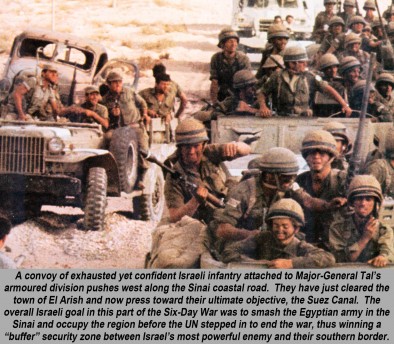
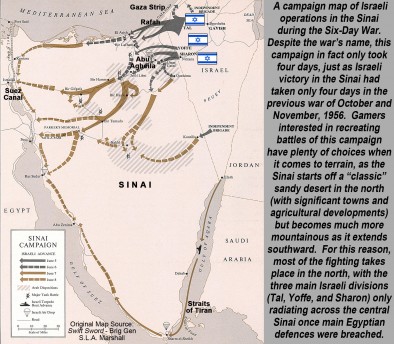

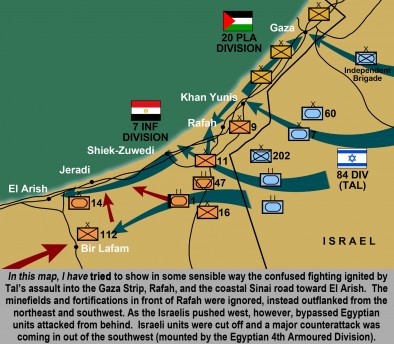
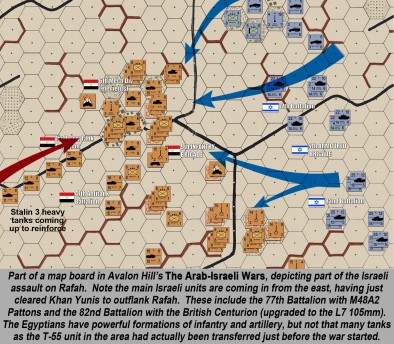

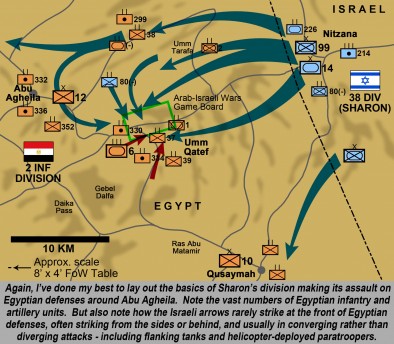
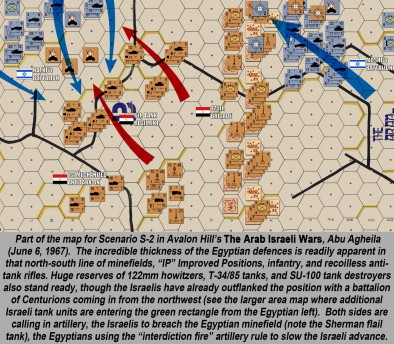
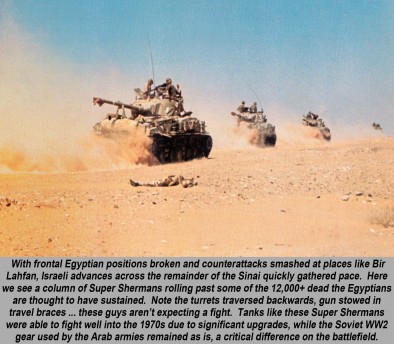
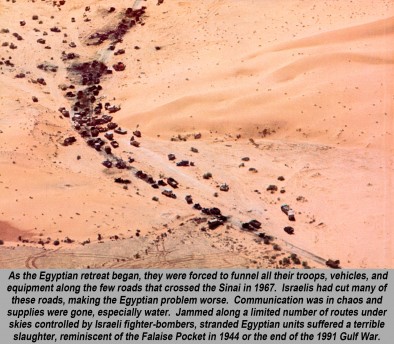
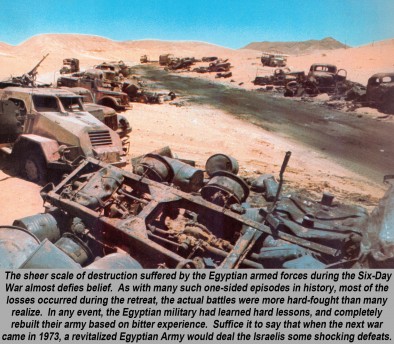


































Another excellent article. I remember this war as a fourteen year old, discussing it in class at school with the art teacher.
Thanks @gremlin! 😀 Glad you liked it. We have one more to go, discussing West Bank, Jerusalem, and the Golan Heights. 😀
Great read. Best digested with a cup of hot coffee
Thanks very much, @rasmus – this is probably my favorite of the three parts of this series, with the largest battles, more intricate maneuvers, and most heavy equipment. 😀
I love reading these articles. I have read about some of the battles in these articles on the Internet but these articles make them lot easier to understand.
I think that the story of how Israel came to be and some of its military achievements are stunning. By rights, it should never have been so successful and when you look at who was lining up against them when they declared independence it’s phenomenal that they won. Time and again Israel has defied odds and triumphed, militarily at least, where a betting man would have put his money elsewhere
Thanks, @onlyonepinman ! I would agree the first 25 years of Israel’s history (War of Independence through Yom Kippur War) is pretty amazing, regardless of where you stand on the “background issues.” As far as “the story of Israel” goes, I’d have to go with the War in 48-49 as the most amazing, simply because this was the only war in which Israel’s existence was ever really in doubt. Ammunition Hill, Radar Hill, Latrun Road, some of those battles really were touch-and-go, and seriously could have crushed the state of Israel before it had a chance to get started. “State… Read more »
Great read, the narrative flows very well. I like the way you interleave the history and comments for the wargamer; looking forward to the next one.
Thanks very much, @itchardpirate – Indeed, the last thing I want is to just present a block of dusty history. This is a wargaming website, so we try to present information in such a way as it will be useful to subscribers. 😀
I always found it kind of amazing that you could have an entire war in six days. I mean I’m used to reading about wars that take years and years. I mean I realized before, and after reading these articles, that it was just the fighting that happened in six days and all the stuff leading up to it I guess could be counted as part of the war. But still, six days.
Thanks, @gladesrunner – the really amazing part is that no single part of this war really took six days. The Israeli fought the Egyptians for four days, the Jordanians for a few days, and the Syrians for just two days. There was some overlap, but at no time the Israelis have to fight all three enemies at once, and the complete SERIES of campaigns wound up taking six days. 🙂
Great installment @oriskany.
It’s funny how over time the individual qualities of the losing side is often lost over time.
The other thing that astounds me are the huge number of similarities between the Arab-Israeli wars and the Russo-Finnish wars of the WW2 period. The war of encirclement here are the mottis of the earlier war, but the similarities goes on and on.
The importance of getting ahead of your enemy’s decision making cycle is also impressed by the Arab-Israeli wars. They also show that movement is one of the powerful weapons in your arsenal.
Thanks very much, @jamesevans140 – I was afraid this article had run its course prematurely. I agree about the qualities of the losing side. The IDF made some of the mistakes in some ways during the War of Attrition 1967-1970 and the brief peace of 1970-73. The overwhelming nature of the Israeli victory prompted many to believe that the Egyptians and Syrians to be “pushovers.” We address this in the interview video recently filmed, also in the “assessment” section of Part Three (Wednesday June 21 to publish). And of course, as anyone familiar with this material knows, the Egyptians addressed… Read more »
Sorry I forgot to mention this. I find it interesting how at times the mixture of doctrines and technology of the opposing sides can come together and yield an unexpected advantage or magnify an existing advantage. One of these occurrences happens here. The first off these is the Israeli training of their tank crews to achieve accuracy at extreme range. Second is Soviet technology. From the T-55, not sure about the T-10, they start using soft core barrels in their tank designs. These barrels are designed to be replaced every 100 rounds or so. They have a snugger fit for… Read more »
Please, no worries, @jamesevans140 – two small posts “does me more good” than one big post. I can reply faster and it helps drive up the comment count. 😀 Great point about doctrine and technology magnifying and advantage. PROPERLY APPLIED – of course. Many of these T-55s, JS-3s, SU-100s, and especially T-34/85s supplied to Egypt were more or less free, as the Soviets tried to build alliances in the region. It just didn’t fit with the doctrine of the Egyptian Army (even as they tried to build the Egyptian Army on a Soviet model), the levels of training available to… Read more »
a great read things would have been totally different if they had coordinated the attacks on Israel at the one time. @oriskany
Thanks @zorg ! Indeed, a more coordinated effort between Egypt, Syria, and Jordan would have definitely made a big difference. The counter-argument to that is, that’s actually tough to achieve that kind of coordination while on defense. Coordination from different directions works better if everyone’s on the attack, and of course the IDF was on the offensive. So would the three Arab states have done better in a coordinated offensive? Honestly, I don’t think so, their armies weren’t really built for it and sure as hell weren’t deployed for it. Note I’m not saying they weren’t acting in a belligerent… Read more »
if as you say they never had the means/resources to go one on one they could still poke the bear from various angels dividing the forcing to coving all the borders
Absolutely. 😀
Thanks for the reply @oriskany. I have a lot interest in the Arab-Israeli wars but little interest surrounding me. Playing solo for me is a bit like a fancy restaurant, great meal but just a rose sitting on the other side. I do a fair bit of solo play in early play testing.
For me the most overlooked army in this region is the Jordanian army. Amazing quality in training and quality. However it is just not big enough to force a decision. I also like their camo on their vehicles.
I know the feeling about not having a lot of gamers in your area interested in the same kind of wargame or topic you may be in. That’s why I’;m always on these planes flying all over hell’s creation to get into good games! 😀
The Royal Jordanian Army gets its due in Part 03 – I promise. 😀 The Battle of Jenin is shown in all its scope (a game I’m actually ashamed to admit I lost rather badly as the Israelis playing against @aras ‘ Jordanian 25th Brigade).
I will be looking forward to it.
I understand your loss to them, given the almost Western quality of their military. This would also be enhanced in a game where the two sides are balanced on simple statistics. E.g.counting rifles.
Thanks, @jamesevans140 . Western equipment, yes, but still earlier Jordanian training and general lack of enthusiasm for the war in which they wanted no part. These factors are clicked into the combat, range, and movement factors in the Jordanian counters in Arab-Israeli Wars, as well as special abilities (split move and fire, etc, antitank values doubling out to certain ranges to reflect ). On the other hand, the game does “click up” the Jordanians after 1967 to reflect post-war reforms. By 1970 (Black September War, Jordan vs. Syria), the Jordanians are doubling their antitank fire out to 1500 meters, for… Read more »
If anyone is interested, Al Jazeera is running a series called “The War in October”, about the yom kippur war.
Thanks for the heads up, @intelligentmistertoad . 😀 Indeed, The Yom Kippur / October / Ramadan War in Octiber 1973 is the biggest of the Arab-Israeli Wars (at least in terms of military operations) and the one I feel has the most wargaming potential.
Great article @oriskany . Our skewed history, written as Cold War propaganda, has always characterized this as an unequal fight, due to the technical superiority of western arms. Also, most of what we see in history books revolves around the retreat, and not the hard-fought battles before it. Very enlightening!
Thanks very much, @cpauls1 ! 😀 In their defense, the Israelis really did upgrade the ever-living daylights out of their gear (i.e., Super-Shermans), whereas the Egyptians and Syrians just basically painted out the red star on their T-34/85s and SU-100s and JS-3s. T-55s were used, but weren’t quite as widespread as many gamers think. In terms of the Jordanian Army, Centurions, AMX-13s, Super Shermans and M48A2s were used against . . . Jordanian Centurions and M48A2s (okay, the Israeli Shermans were usually upgraded to the “Sho’t” level with 105mm L7s, while Jordanians Centurions were only 20-pounders as seen at Jenin).… Read more »